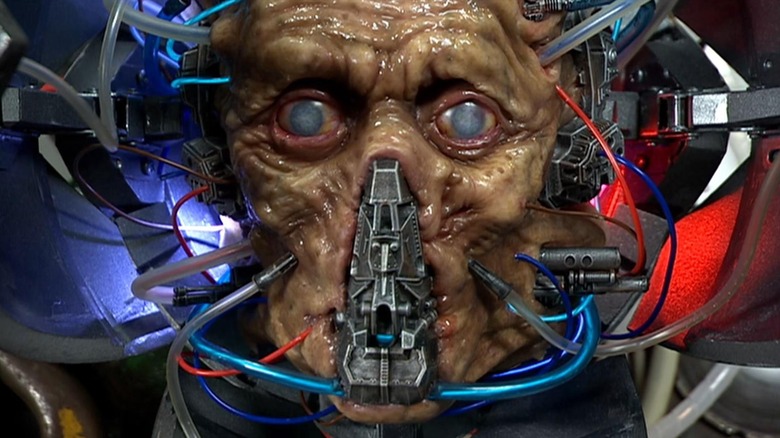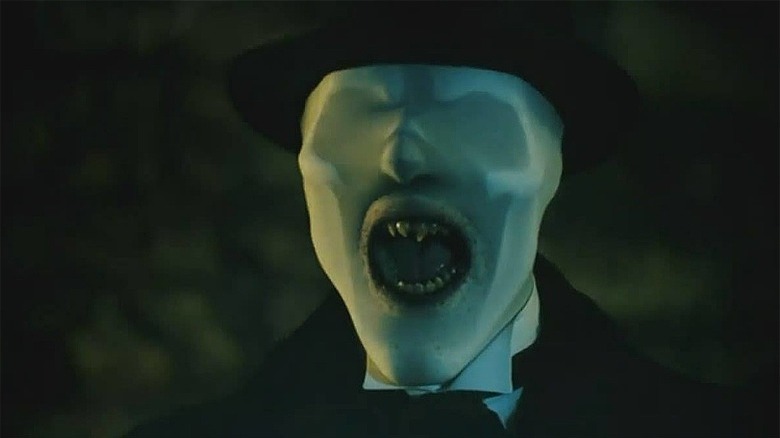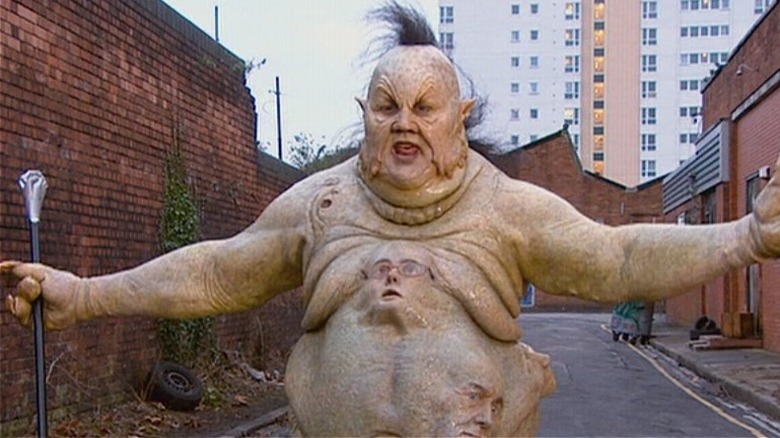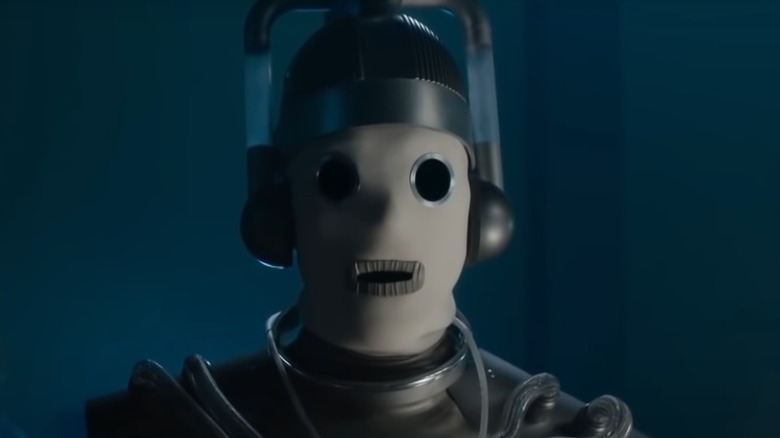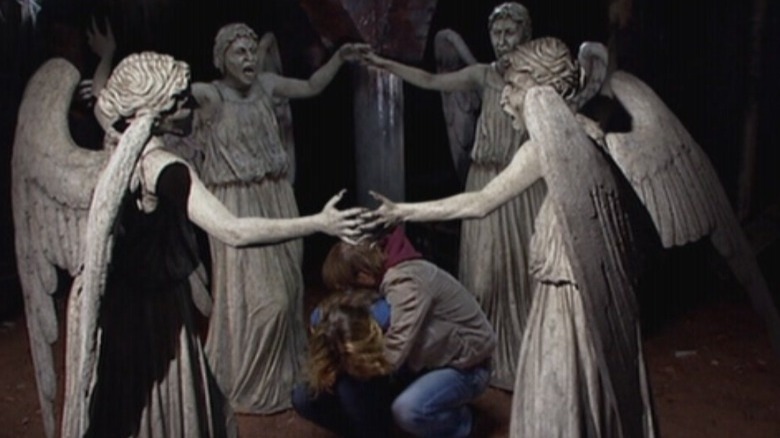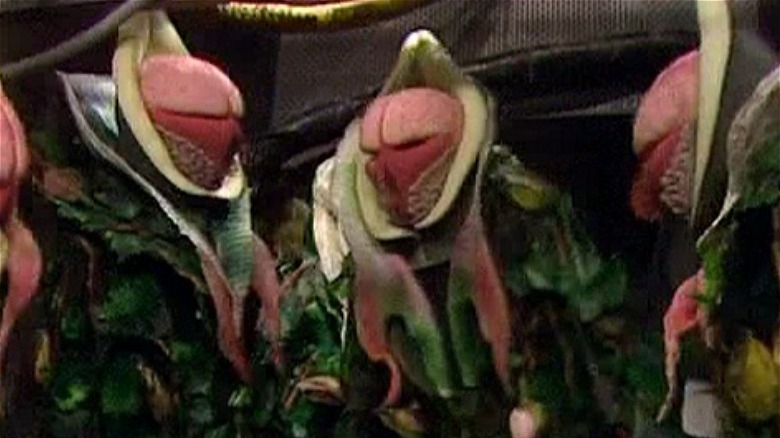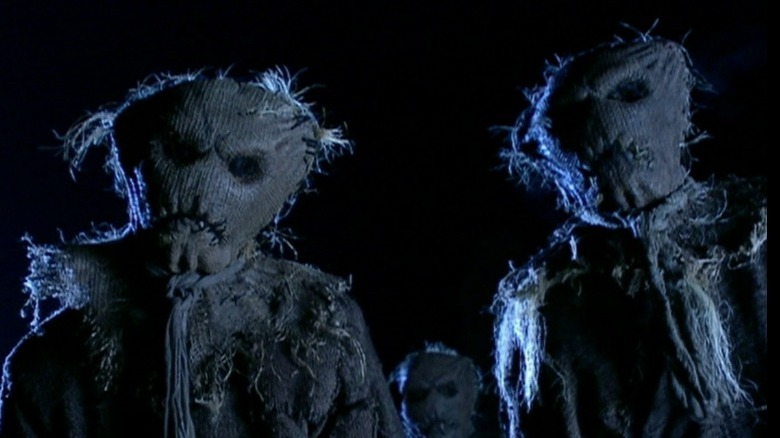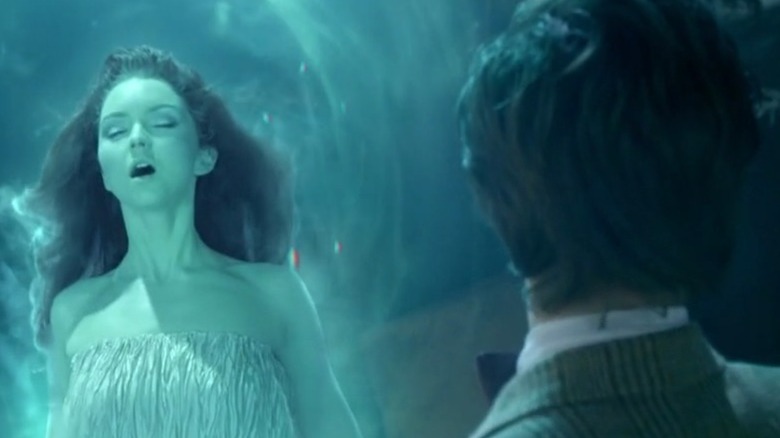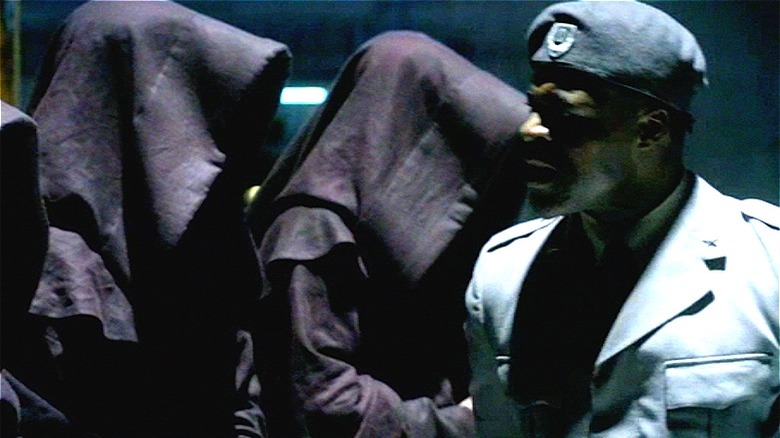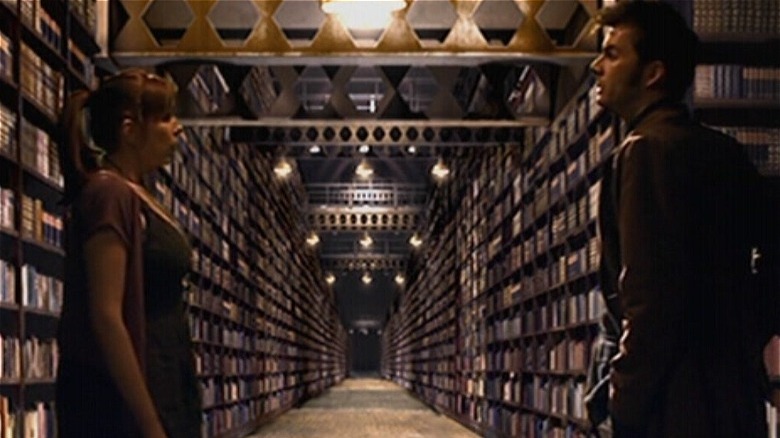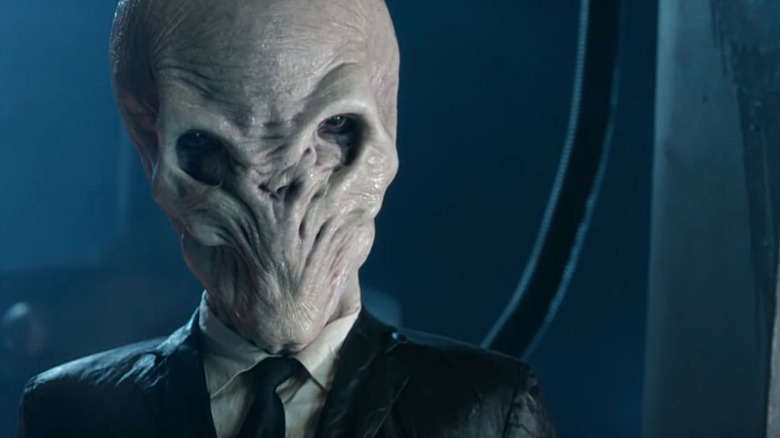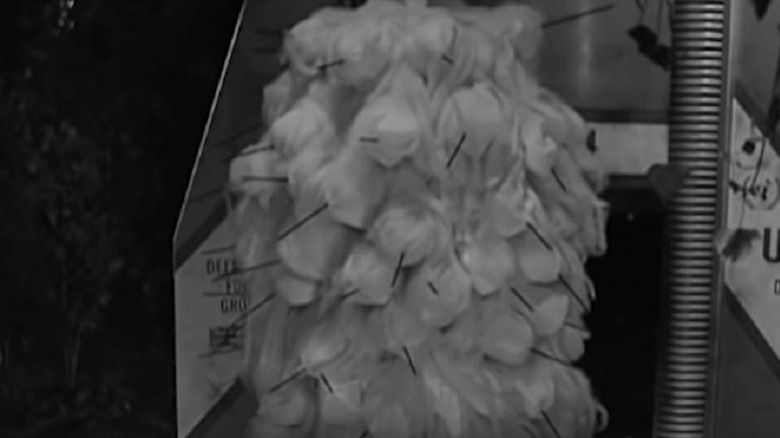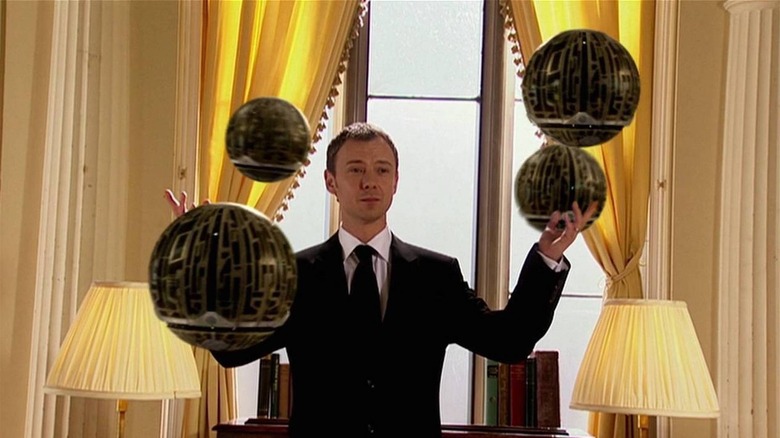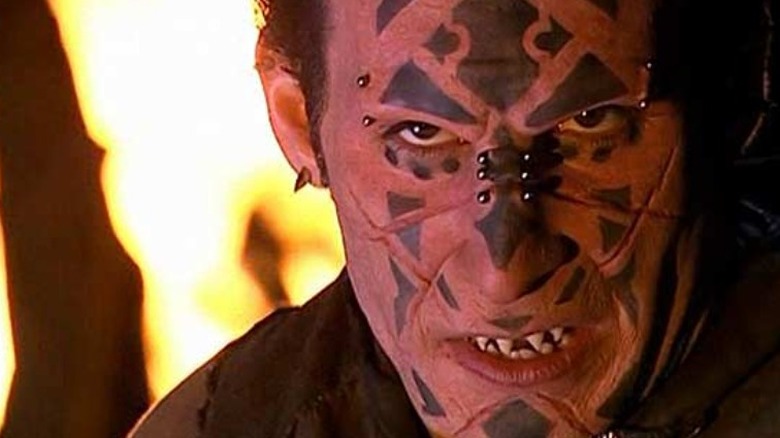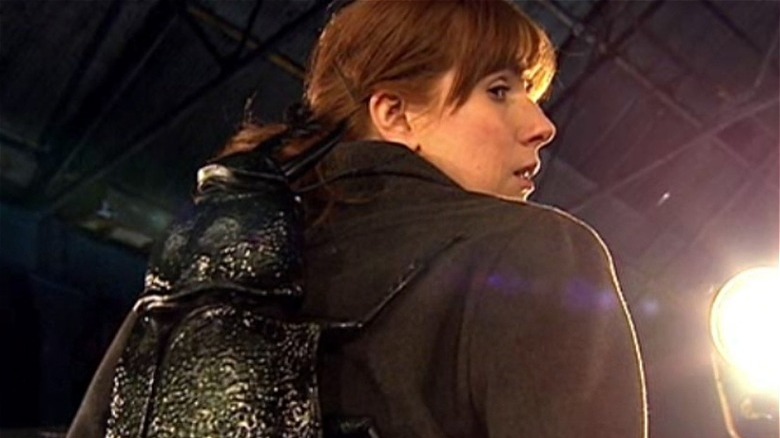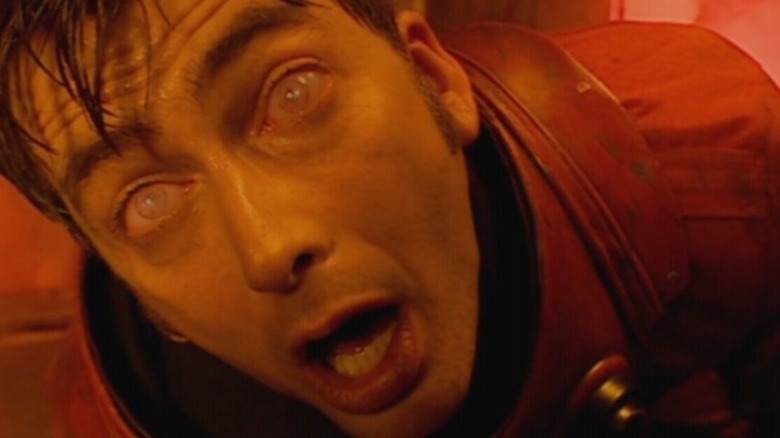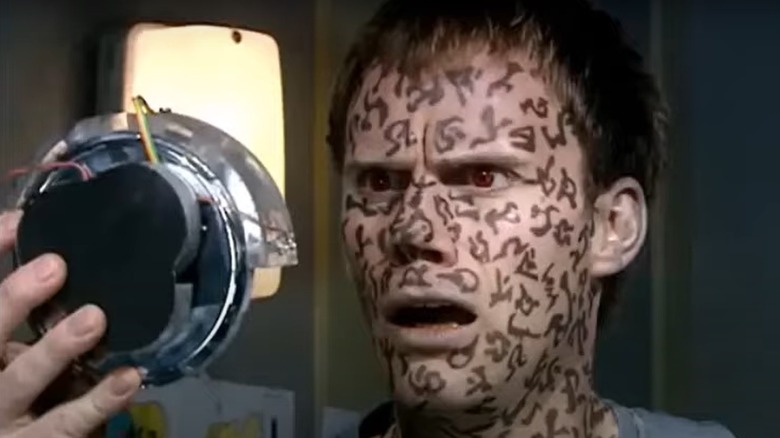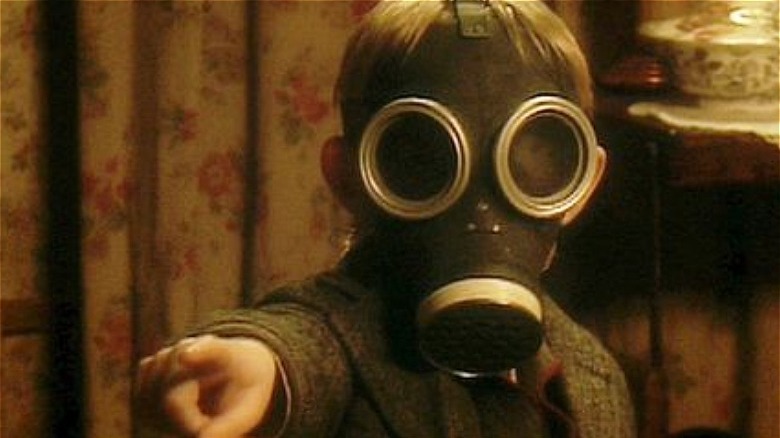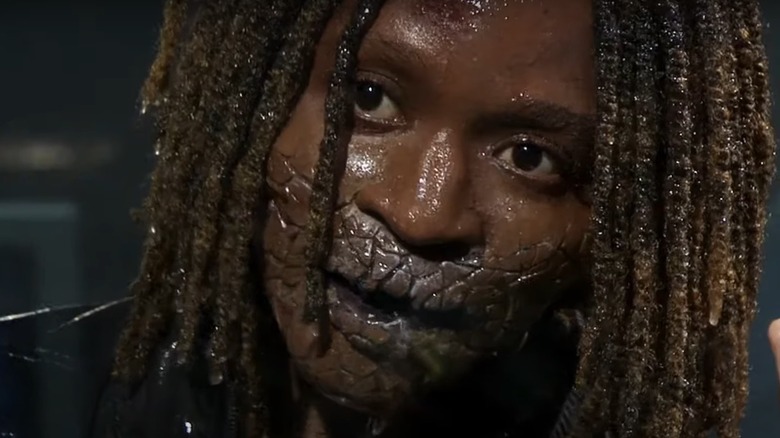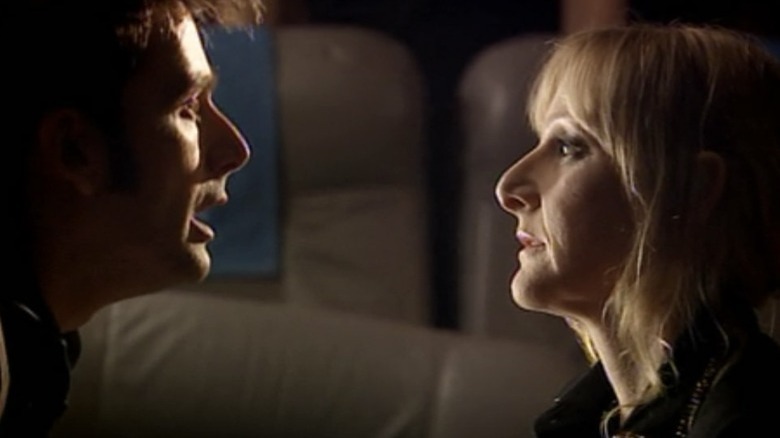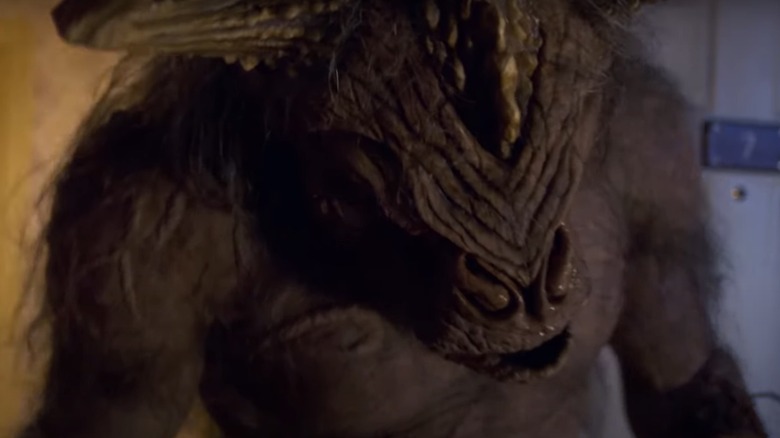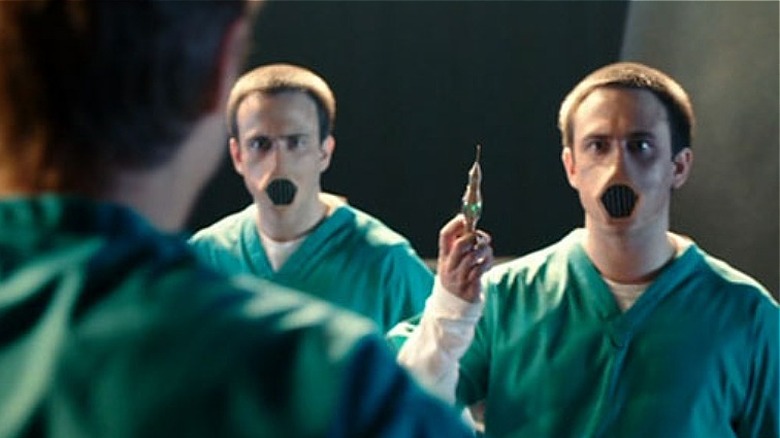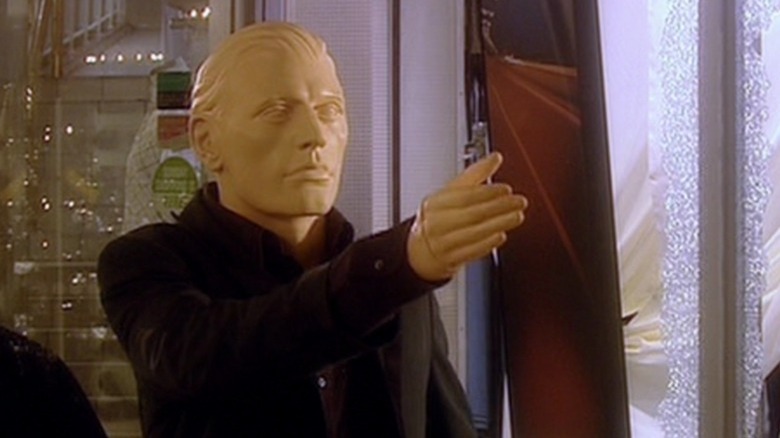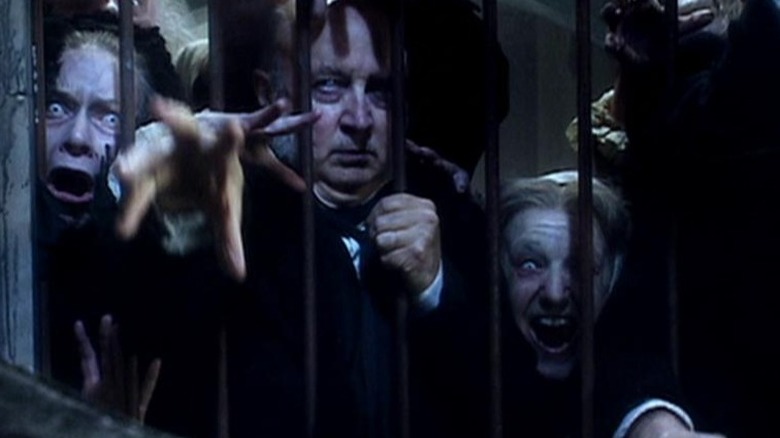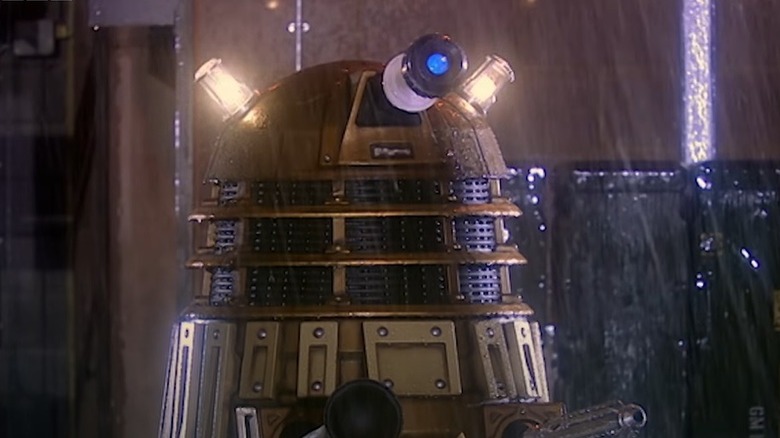Doctor Who Aliens That Totally Creeped Us Out
Originally conceptualized as a semi-educational series that taught kids about history and science, "Doctor Who" has grown from a cult favorite to one of the most beloved sci-fi franchises ever. It follows the exploits of a time-traveling alien known as the Doctor, a so-called Time Lord who darts across the universe in his police box-shaped spacecraft righting wrongs, helping humanity, and having various chaotic adventures. The series has managed to reinvent itself several times since debuting back in 1963, thanks in no small part to a clever plot device known as regeneration, which allows the Doctor to avoid death by getting reborn in a new body. The show we know and love today began to take shape towards the end of the 1960s, when it became less about education and more about aliens.
Even in the pre-CGI era, "Doctor Who" was serving up memorable and legitimately terrifying alien characters. The BBC series is actually responsible for the phrase "hiding behind the sofa," a term coined by reporter Stanley Reynolds in a 1973 review. "The whole point of Doctor Who's adventures in time and space is that they are scary and menacing," Reynolds wrote in The Times. "The Daleks are the boss space horrors, something to get the children hiding behind the sofa in happy anticipation of 25 minutes of fear." Clear a space behind your couch, because we're about to take a look at the creepiest "Doctor Who" aliens ever.
The Whisper Men
When there's a nursery rhyme in "Doctor Who," it's typically not something you'd want to read to your kids at bedtime. Just when you thought the Whisper Men couldn't get any scarier with their bony, featureless faces and jagged teeth, the show goes and gives them a creepy little song that sticks with you. Heard in the 2013 episode "The Name of the Doctor," it goes: "Do not hear the Whisper Men / Whatever else you do / For once you've heard the Whisper Men / They'll stop and look at you."
Even without the creepy nursery rhyme, the Whisper Men are pure nightmare fuel. Enforcers for the Great Intelligence, they communicate by emitting telepathic messages from their hissing, gaping mouths. Besides being extremely hard to vanquish, the Whisper Men possess several unsettling abilities like a knack for disappearing and reappearing, killing with only a whisper, and stopping human hearts. The fact that they dress in a way that we can only describe as undertaker chic makes them all the more spooky.
The Abzorbaloff
The demented love child of "Dune" villain Baron Vladimir Harkonnen and Fat B****** from the "Austin Powers" films, the Abzorbalovian the Doctor calls "the Abzorbaloff" is one of the most disgusting and disturbing aliens to cross paths with the Time Lord. To the upbeat sounds of ELO, the Abzorbaloff wanders around London absorbing his victims in the style of The Blob. But it's not just that he absorbs them with a simple touch.
Once the Abzorbaloff's victims are embedded in his absorption matrix, their faces are visible in his flesh as they are slowly absorbed over the process of several weeks. And worse, they remain conscious and self-aware, at least at first. The process can't be reversed once it has begun, which means victims are left to slowly witness their own demise. This awful alien is played by English standup comedian Peter Kay in the 2007 episode "Love & Monsters," but there's nothing funny about it.
The Cybermen
With their empty faces and soulless chrome bodies, the Cybermen are one of the Doctor's oldest adversaries, dating back to the 1966 episode "The Tenth Planet." Sure, they're kind of slow and could probably be outrun just as easily as a George A. Romero zombie theoretically could be, but their appearance is so jarring that victims generally stop and stare until they are overcome. Once humans, Cybermen have a way of popping up in various universes and worlds as part of the species' natural evolution, arising from the very human obsession with immortality.
Without individual personalities or interests, Cybermen have a pretty narrow focus in life. They want to either upgrade everyone they meet or simply delete them from existence. And if you think that's terrifying, you should see the Cybershades, super creepy variants with bronze faces that scurry along on all fours. As seen in the 2008 episode "The Next Doctor," these agile beasts serve the far more intelligent Cybermen.
The Weeping Angels
Millions of "Doctor Who" fans would never look at statues the same way again after the Tenth Doctor (David Tennant) told Sally Sparrow (Carey Mulligan) about the Weeping Angels in "Blink," thought of by many Whovians as the best "Doctor Who" episode ever. The ancient Lonely Assassins of the universe, the Angels are quantum-locked humanoids that turn to stone when anyone looks at them, even other Angels. Their defense mechanism is so effective that Angels have to cover their own eyes when looking at each other.
When they touch their victims, the Angels send them into the past, feeding off the time energy of their misplaced lives. If this makes less sense the more you think about it, don't even begin to contemplate how baby Weeping Angels are made. There's just something absolutely petrifying about a superfast psychopathic murderer keen on conducting the world's most deadly staring contest.
The Vervoids
When it comes to sentient plants, not every race can be as lovely as the Trees of Cheem, and some are downright frightening. Take the Vervoids, for example. Created from plants by scientists for use as a slave race, the Vervoids eventually went full Cylon and turned on their human overlords. We can't argue with that from a moral standpoint, but the Vervoids are just plain freaky, from their handlike tendrils to the deadly swamp gas they release from what we have to assume are mouths.
While their heads are slightly reminiscent of a botanical Storm Trooper helmet, that's not the only thing they look like. As quite a few fans have pointed out over the years, their faces have a somewhat NSFW appearance that's more than a little unsettling. Once you see it, it can't be unseen. Author and film critic Darren Mooney called them "perhaps the most Freudian monster in the history of 'Doctor Who.'"
The Family of Blood Scarecrows
2007 "Doctor Who" episode "The Family of Blood" stars a very young Harry Lloyd (perhaps best known for playing Viserys Targaryen, the brutally-executed brother of Daenerys Targaryen in "Game of Thrones") as an Edwardian-era schoolboy. Even in 1913, boys will be boys. However, Jeremy Baines isn't a normal boy — he's been possessed by a gaseous predator who wants to kill the Doctor and take his immortality. That's pretty creepy, but the army of scarecrows he creates to do his bidding is even creepier.
Made from straw and relatively slow and awkward, the scarecrows are easily taken down with a few bullets. But once they're down, these Oogie Boogie-looking straw zombies don't stay down. With a word from Jeremy, they quickly reanimate, lumbering forward once more. They're far from agile, but there is something utterly chilling about soulless scarecrow zombies with burlap sacks for heads.
The Siren
The Doctor finds himself aboard a troubled pirate ship in the 2011 episode "The Curse of the Black Spot." Captain Henry Avery (Hugh Bonneville) and his crew are at the mercy of a beautiful but terrifying woman who appears to be luring men to their deaths. After the ship becomes marooned, anyone who experiences an injury, no matter how minor, receives a black mark on their hand.
Crewmembers who get the mark are soon pursued by a glowing Siren who causes them to disappear, seemingly disintegrating them. After Rory (Arthur Darvill) nearly drowns, Amy (Karen Gillan) and the Doctor discover that the Siren is actually just an automated medical system left in limbo after the crew it served died unexpectedly of disease. With no medication left to give, all it can do is put the sailors on life support. It's an understandable mix-up — it looks more like a demon than a doctor when its eyes begin to glow red.
The Order of the Headless
As movies like "The Exorcist" have proven, religion and horror can be a winning combination. That combination is exactly what makes the Headless Monks so creepy. So devout that they remove their heads so that they won't get sidetracked with things like critical thinking, the Order of the Headless worship the Papal Mainframe. They channel energy into their hands and perform energy blasts (think the Hadouken attack from the "Street Fighter" series), making them formidable foes, despite lacking traditional senses.
Not the type of people to waste perfectly good body parts, they hoard their heads in ceremonial boxes. Detached heads aren't even the creepiest thing about them — their spare neck skin, now dried out, is tied up in a neat little twist that looks like a small onion. Yes, it's as gross as it sounds. They are aligned with the Silence, another religious order dedicated to defeating the Doctor.
The Vashta Nerada
Have you ever peered into a shadowy corner of a room and felt like it doesn't look right? You can't quite put your finger on it, you just know that something's not as it seems. In the "Doctor Who" universe, this sensation is sometimes the result of the Vashta Nerada, microscopic flesh-eating beings that lurk in the darkness. When it comes to the Vashta Nerada, putting your finger on it is actually a terrible idea.
The Doctor once referred to them as the "piranhas of the air," telling companion Donna Noble (Catherine Tate) that their name literally means "the shadows that melt the flesh" after tossing a chicken leg into a swarm and watching it get instantly stripped to the bone. They're the reason that most creatures are afraid of the dark, as they can be found in every corner of the universe.
The Silence
The Whovian embodiment of Edvard Munch's famous painting The Scream, the Silence is an order of genetically-engineered priests that belongs to the Church of the Papal Mainframe. While they're chilling to look at with their lanky features, electricity-shooting hands, sunken eyes, and mouthless faces, that's not what makes the Silence so creepy. Anyone who sees the Silence immediately forgets that they have seen them the second they look away, a trait that gives them the ability to slip in and out of history, altering the timeline with ease.
The need to track such encounters leads to the precautionary practice of using a Sharpie to draw tally marks all over one's body, which in itself is frightening. Just imagine — one moment, you're in the kitchen eating fish fingers and custard (the only combination that satisfied the Eleventh Doctor after his regeneration), and the next you're covered in ominous tally marks with no recollection of how they got there.
The Varga Plant
Sadly, several early "Doctor Who" episodes were not committed to the BBC archives (as was the practice at the time) and have therefore been lost for good. In a feat that demonstrates just how much fans of "Doctor Who" care about the show, the staff and students of the University of Central Lancashire worked tirelessly to recreate one such episode, 1965's "Mission to the Unknown." If it wasn't for their heroic efforts, younger Whovians would never have experienced the creepiness of the Varga plant.
Native to the planet Skaro, the Varga are cacti-like sentient beings that are "part animal, part vegetable," according to UN Deep Space Force Group 1 astronaut Marc Cory (played by Edward de Souza in the original episode). The Varga look a bit like pulsating cotton, dragging themselves along the ground by their roots. They have poison-tipped thorns that replace rational thoughts with an "overwhelming desire to kill." If that wasn't bad enough, the unfortunate victims slowly transform into Varga themselves.
The Toclafane
The Toclafane are what remains of humanity some trillions of years into the future, and it's a bleak future indeed. Reduced to gooey cyborg heads in weaponized spheres, they have built-in Darth Vader-style life support systems to keep them going. After a failed attempt at reversing the aging process, the Toclafane devolved into one hive mind with a permanently childlike mentality.
They enjoy killing their ancestors because it's a jolly good time, apparently (in the episode "Last of the Time Lords," they declare that "it's fun" to hunt humans). After all of the Doctor's running about through space and time to promote humanity's bright future, it's horrifically unsettling to think that the human race could spend their final days as shriveled murder balls. The fact that the Toclafane have the minds of children underneath it all is just plain terrifying.
The Futurekind
The downfall of civilization seems almost inevitable in the world of "Doctor Who," and for humanity, things don't look very good. While it's horrifying to imagine the last living humans becoming the childlike murder balls known as the Toclafane, the creatures they're fleeing aren't so hot either.
Lingering at the end of time is another sort of devolved human, the Futurekind. A poorly-tatted race of mutated humanoids that have regressed to using primitive weaponry and a limited language, they have some pretty gnarly teeth that they use to hunt and kill the remaining living humans. What's even worse than that is their fashion sense.
For reasons unknown, these horrid aliens dress like they're cosplaying as Darth Maul. But as per usual in the Whovian canon, it's more what they represent that makes them creepy, and what they represent is the inevitable demise of the human race.
The Time Beetle
You've probably heard of the butterfly effect — not the Ashton Kutcher movie, the idea that one small choice in a person's life creates a cascade of events that leads to significant changes over time. In "Doctor Who," it's a giant beetle that upsets the timeline and gets the Doctor killed after Donna Noble has a chance encounter with a sketchy fortune teller in "Turn Left."
Its appearance is fairly tame by Whovian standards since it's basically just a beetle. But because the time beetle exists in a state of flux, attaching itself to the backs of its victims where it can be sensed but not exactly seen, it leaves its victims with a vague and fleeting sense that something is profoundly off. Normies barely notice a difference in most cases, but for someone as essential to the stream as Donna, the time beetle can create a parallel world around them, with dire consequences.
Torajii
"Doctor Who" is full of unlikely sentience, from sentient rocks to sentient plants. Rocks and plants can be avoided by simply staying indoors, however. What's far harder to avoid when you're a universe-hopping Time Lord are sentient stars. Torajii (the star at the center of the Torajii system) is alive, and, like so many horrors in "Doctor Who," it loves a good full-body possession.
In the episode "42," the Doctor and Martha Jones (Freema Agyeman) encounter Torajii's power firsthand: It converts your oxygen into hydrogen and gives you glowing eyes that it can use to incinerate your shipmates. The Doctor gets possessed by the powerful star, but fortunately, it is willing to listen to reason. It's just upset because a passing cargo ship has (illegally) taken some of its gas. The crew in question probably would have thought twice about what they were doing had they known they were stealing from a vengeful sentient star.
The Beast of Krop Tor
Pseudo-demonic forces are a dime a dozen in the Whoniverse, but few are more terrifying than the Beast of Krop Tor in "The Impossible Planet." This episode plays around with one of the series' favorite themes: Possession. As is so often the case in "Doctor Who," the Doctor and his companion (in this case Rose) stumble upon a crew of space-bound blue-collar workers in distress and get caught up in their mess.
The drama unfolds just outside the gravity well of a black hole. A creature claiming to be Satan starts possessing the enslaved Ood above the ship and rapidly moves on to humans, covering poor archaeologist Toby's face with ancient markings and turning his eyes red. Through the possessed Ood, the Beast tells the Doctor he is older than time and the legend behind all of the devil myths in the universe. Whatever he is, the Beast accurately predicts Rose's fate and cold reads the crew with precision. Maybe he really was the devil after all.
The Empty Child
Some of the best and most terrifying aliens in "Doctor Who" fall under the category of alien technology that has somehow become accidentally frightening, like the Siren in "The Curse of the Black Spot" or the Empty Child in the episode of the same name. When a creepy little boy in a gas mask starts asking random Londoners "Are you my mummy?" during the Blitz, the already traumatized locals are understandably unsettled.
What's even more unsettling is the fact that the boy is actually a reanimated corpse, the result of some Chula nanogenes that escaped from a crashed medical ship. The so-called Empty Child was once a kid named Jamie, but he died in the bombing. Having no experience with humans, the nanogenes believed the gas mask to be part of our anatomy. As such, the mask was fused to Jamie's face. Luckily, all it takes is a little Gallifreyan tech support to get things on track again, and as the Doctor happily proclaims, "Just this once, everybody lives!"
The Flood
The idea of humans on Mars may be closer than ever before, but the place remains a mystery to us. In the world of "Doctor Who," there's something microscopic and terrifying lurking underneath the surface of the Red Planet. A virus that lives in water and is, in fact, water itself, the Flood infects every living being that has water in its composition. And since humans are mostly water, things go very badly for an early team of Martian colonists in what is arguably one of the most terrifying episodes of "Doctor Who" ever, the Hugo Award-winning "The Waters of Mars."
Once a human becomes infected with the funky Mars water, they begin to experience some pretty intense symptoms that include distressingly cracked skin around the mouth, blackened teeth, a tendency to vomit water at high velocity, and zombie-like behavior. Looks like humanity's first Mars colony could use a Brita sponsorship.
The Haemovores
When it comes to terrifying monsters, vampires are always a solid bet, which is exactly why "Doctor Who" keeps finding new and novel ways to bring bloodsuckers on board. The Haemovores are the creepiest of these creations by far. In the episode "The Curse of Fenric," the Seventh Doctor encounters the Haemovore Ingiger, who is awakened as part of a bid to kill the Time Lord.
Haemovores came about on a pollution-riddled Earth in 500,000 A.D., feeding on plankton in the chemical swamps that make up the planet. When Fenric brings the Haemovores to medieval Transylvania, they develop a taste for blood, eventually giving rise to the Dracula legend. With their grayish, crusty skin and lengthy claws, they look a bit like the love children of Nosferatu and the Rock Biter from "The NeverEnding Story." And with their bloodlust and pollution swamp roots, they are definitely super creepy.
The Midnight Entity
Visually creepy aliens are one thing, but "Doctor Who" also does psychologically terrifying bad guys. In the 2008 episode "Midnight," the Doctor takes a day trip to the planet Midnight, a tourist destination known for its diamond glaciers and sapphire waterfall. But if one thing is certain when it comes to "Doctor Who," it's that there's always something creepy lurking in the dark. In this instance, that something thrives on paranoia.
When the tour bus breaks down, an unknown entity begins to knock it around like a scene from "Paranormal Activity," causing the frightened passengers to become somewhat unhinged. Things escalate when the entity riles up the mob and the Doctor gets tossed out into the deadly X-tonic light. It's one of the few times we've seen the Doctor (who is on the trip without a companion) completely helpless: A heroic hostess comes to his rescue. It's never clear what the entity wanted with the passengers other than to relish in the chaos it caused.
The Minotaur
The Whovian answer to Pennywise, the Minotaur feeds on the fear of its victims — or so the Doctor believes at first. This creepy creature menaces the Time Lord and the Ponds in the episode "The God Complex." When the TARDIS inexplicably lands in a kitschy 1980s hotel instead of its intended destination, the travelers quickly deduce that they are trapped in a labyrinth. Worse, the hotel seems to be providing them with a steady stream of their worst fears.
Thanks to Rory's lack of belief in anything, the gang is able to figure out that it's not their fears the creature craves but their beliefs, which is arguably just as creepy. It turns out that the hotel is a space prison and the Minotaur was locked away by those who grew tired of worshipping it as a diety. Its former subjects weren't totally heartless, however — the ship is programmed to suck in unsuspecting passers-by as food.
The Shakri Orderlies
Technically human, the Orderlies are abductees who have been transformed by the Shakri, the interdimensional pest controllers who decide to check humanity off of their to-do list in "The Power of Three." When the world suddenly becomes populated with millions of mysterious black cubes, humanity puzzles over the meaning, with some even speculating that it's a clever viral marketing campaign. As it turns out, it's the work of the Shakri, which the Doctor learns shortly after the cubes begin activating.
As part of their protracted genocidal antics, the Shakri have been transforming humans into slaves, and for some reason, this involves turning their mouths into grills. Despite the simplicity, the body horror of this change makes the Shakri hybrids one of the most disturbing creatures in the series. In some ways, they are creepier than the most disgusting aliens in the Whoniverse because we can relate to them.
The Nestene Consciousness
Another example of the show's ability to make things that technically shouldn't be scary into nightmare fuel is the Nestene Consciousness. Thanks to their disembodied hive mind and ability to animate plastic, the Nestenes have a way of popping up in some of the most unexpected places, from a department store basement to a Christmas tree.
While it might seem a little childish to be scared of mannequins coming to life and lumbering about, anyone who has ever walked through an empty department store after closing time knows that there's something deeply unsettling about the thought of empty plastic people lurking in the shadows. Playing on the uncanny valley phenomenon, the Nestene Consciousness is one of the creepiest concepts in the long history of "Doctor Who," especially when they emerge as Autons like the Mickey Smith copy in the episode "Rose."
The Gelth
Transformed into gas during the Last Great Time War, the Gelth are wraithlike creatures that made their way into Victorian Wales during the Cardiff Rift, which would feature prominently in the "Doctor Who" spinoff series "Torchwood." Unlike the kind of "Doctor Who" villains who come out teeth and tentacles bared, the Gelth use subterfuge to convince Gwyneth and the Doctor that they are perfectly friendly beings on the verge of extinction and they just need a place to crash, that place being the corpses of humanity's dead, which they plan to recycle and inhabit.
Seems quite reasonable, right? Wrong. The thing with the Gelth is, if you give them an inch, they'll soon try to take a mile. When it's revealed that these creepy blue aliens actually plan to take over the Earth, the Doctor does what the Doctor does best and sends them packing.
The Daleks
Considering that they are basically plungers attached to giant salt shakers, the Daleks shouldn't be nearly as scary as they are. And yet, after dozens of terrifying aliens and decades of advances in special effects, many "Doctor Who" fans still find Daleks to be the scariest "Doctor Who" antagonists of them all. That's because like so many "Doctor Who" villains, what makes Daleks terrifying is the psychological horror of who they are and what they represent.
Once a race of people called the Kaleds, Daleks have whittled away at their humanity until there's nothing left but hatred, locking what remains of their soulless, withered bodies behind an armored shell. The shells were created by a mad scientist-type named Davros, who promised to help the Kaleds triumph in their war with their neighbors, the Thals. In a world where humans already spend much of our time hidden behind our smartphones or computer screens, the warning has never been more relevant.
